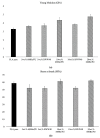Evaluation of Mechanical and Interfacial Properties of Bio-Composites Based on Poly(Lactic Acid) with Natural Cellulose Fibers
- PMID: 30813291
- PMCID: PMC6413052
- DOI: 10.3390/ijms20040960
Evaluation of Mechanical and Interfacial Properties of Bio-Composites Based on Poly(Lactic Acid) with Natural Cellulose Fibers
Abstract
The circular economy policy and the interest for sustainable material are inducing a constant expansion of the bio-composites market. The opportunity of using natural fibers in bio-based and biodegradable polymeric matrices, derived from industrial and/or agricultural waste, represents a stimulating challenge in the replacement of traditional composites based on fossil sources. The coupling of bioplastics with natural fibers in order to lower costs and promote degradability is one of the primary objectives of research, above all in the packaging and agricultural sectors where large amounts of non-recyclable plastics are generated, inducing a serious problem for plastic disposal and potential accumulation in the environment. Among biopolymers, poly(lactic acid) (PLA) is one of the most used compostable, bio-based polymeric matrices, since it exhibits process ability and mechanical properties compatible with a wide range of applications. In this study, two types of cellulosic fibers were processed with PLA in order to obtain bio-composites with different percentages of microfibers (5%, 10%, 20%). The mechanical properties were evaluated (tensile and impact test), and analytical models were applied in order to estimate the adhesion between matrix and fibers and to predict the material's stiffness. Understanding these properties is of particular importance in order to be able to tune and project the final characteristics of bio-composites.
Keywords: bio-composites; cellulose fibers; mechanical properties; poly(lactic acid).
Conflict of interest statement
The authors declare no conflict of interest.
Figures







References
-
- Hornsby P., Hinrichsen E., Tarverdi K. Preparation and properties of polypropylene composites reinforced with wheat and flax straw fibres—Part 2: Analysis of composite microstructure and mechanical properties. J. Mater. Sci. 1997;1:1009–1015. doi: 10.1023/A:1018578322498. - DOI
-
- Liang J.Z., Ma W.Y. Young’s modulus and prediction of plastics/elastomer blends. J. Polym. Eng. 2012;32:343–348. doi: 10.1515/polyeng-2012-0006. - DOI
-
- Oksman K., Skrifvars M., Selin J.F. Natural fibres as reinforcement in polylactic acid (PLA) composites. Compos. Sci. Technol. 2003;63:1317–1324. doi: 10.1016/S0266-3538(03)00103-9. - DOI
-
- Râpă M., Popa M., Cinelli P., Lazzeri A., Burnichi R., Mitelut A., Grosu E. Biodegradable Alternative to Plastics for Agriculture Application. AcRomanian Biotechnol. Lett. 2011;16:59–64.
MeSH terms
Substances
Grants and funding
LinkOut - more resources
Full Text Sources

